Leadership and Workforce: Impact on Performance Analysis Report
VerifiedAdded on 2023/01/23
|14
|2745
|27
Report
AI Summary
This report examines the impact of leadership on workforce performance, focusing on key areas such as employee motivation, enhanced process design, understanding training needs, conflict resolution, and monitoring operational processes. It begins with an introduction outlining the research aim, objectives, questions, and hypothesis, followed by a comprehensive literature review that explores the role of leadership in motivating employees through rewards and recognition, guiding them toward common objectives, and enhancing process design through consultation and collaboration. The report also delves into how leaders identify training needs and mitigate workplace conflicts to ensure smooth operations. The chosen methodology employs a positivism philosophy and a deductive approach, utilizing an explanatory research design and mixed methods for data collection, including questionnaires and secondary data from peer-reviewed journals and company reports, to establish a cause-effect relationship between leadership roles and workforce performance. This assignment is available on Desklib, a platform offering a wide range of study resources for students.
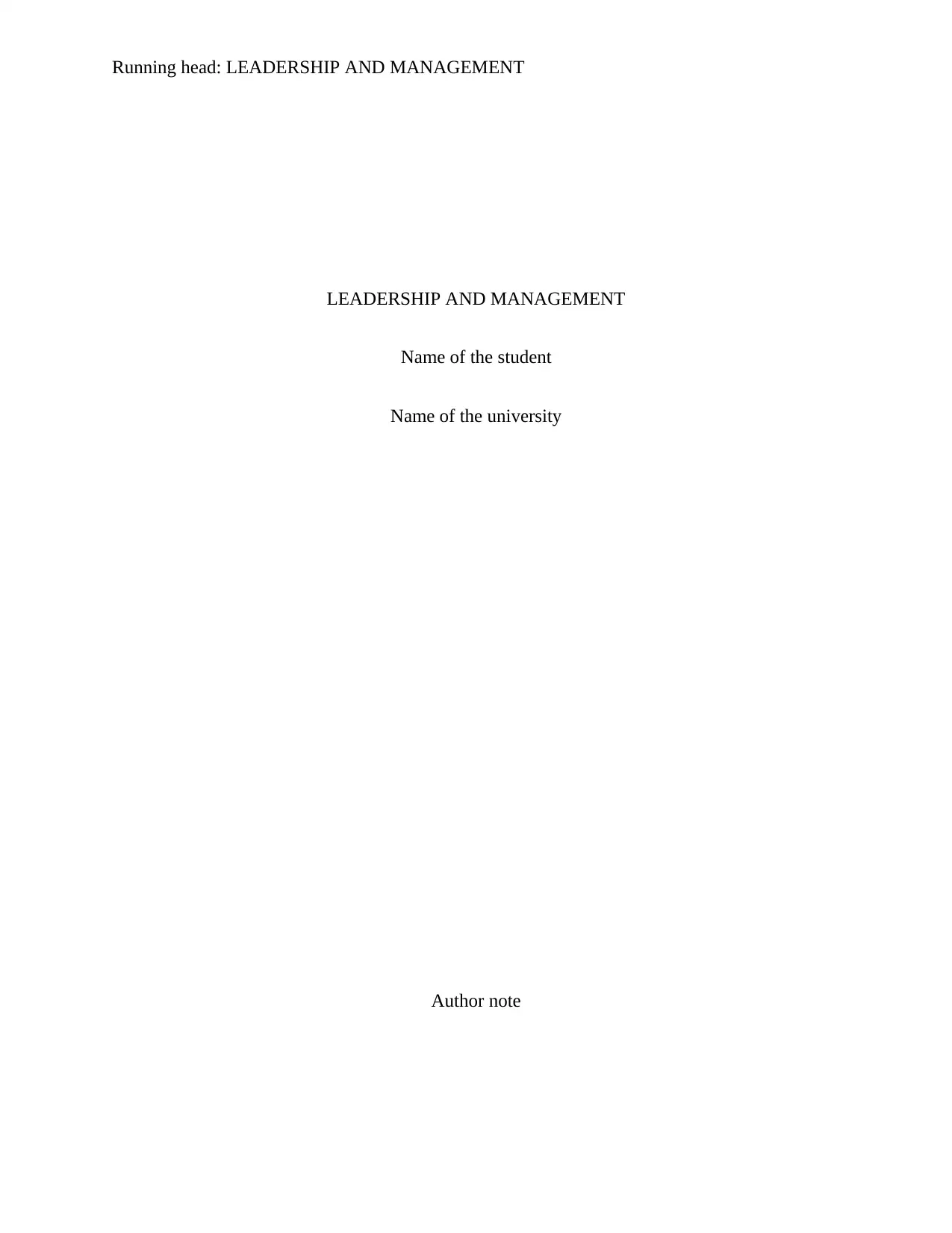
Running head: LEADERSHIP AND MANAGEMENT
LEADERSHIP AND MANAGEMENT
Name of the student
Name of the university
Author note
LEADERSHIP AND MANAGEMENT
Name of the student
Name of the university
Author note
Paraphrase This Document
Need a fresh take? Get an instant paraphrase of this document with our AI Paraphraser
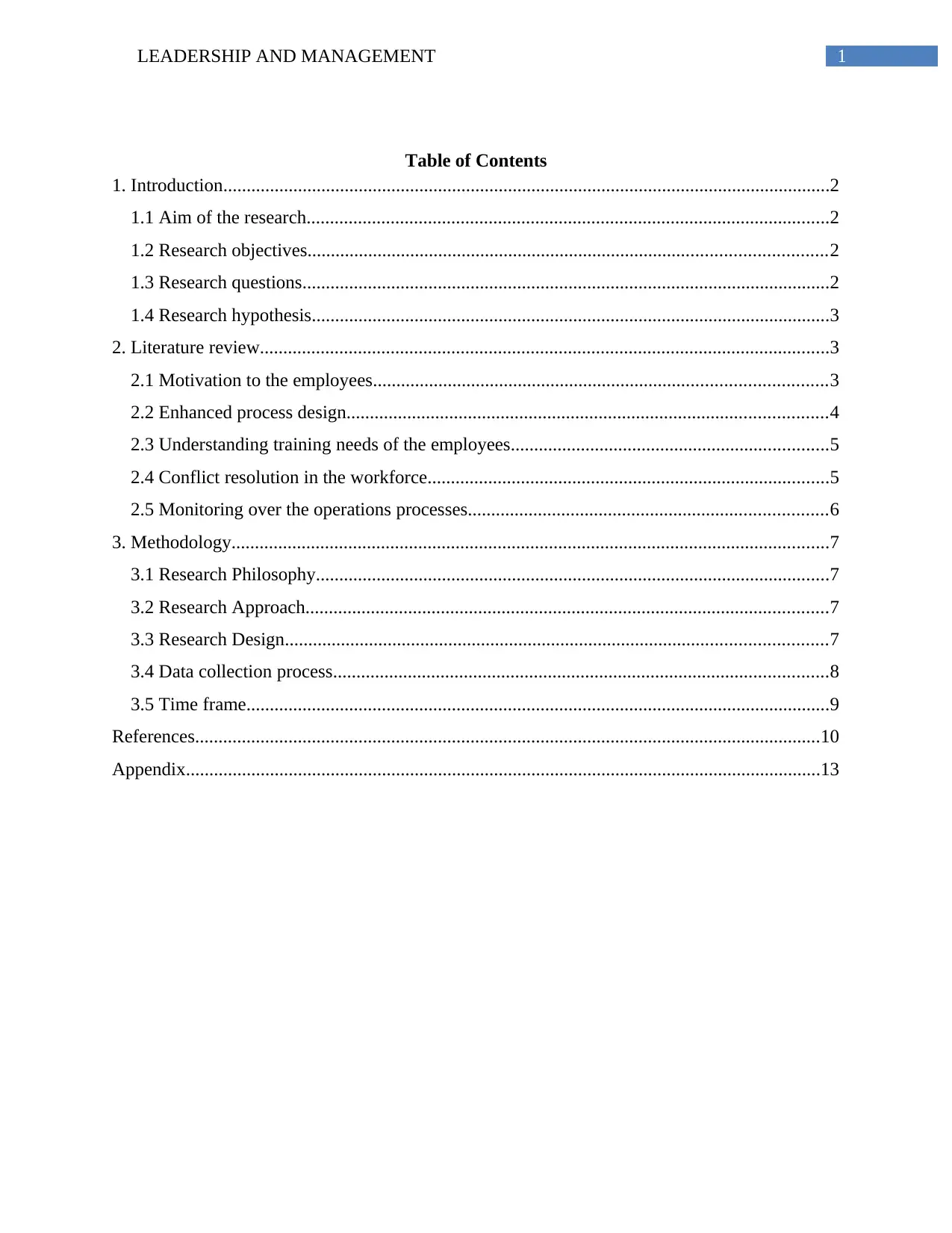
1LEADERSHIP AND MANAGEMENT
Table of Contents
1. Introduction..................................................................................................................................2
1.1 Aim of the research................................................................................................................2
1.2 Research objectives...............................................................................................................2
1.3 Research questions.................................................................................................................2
1.4 Research hypothesis...............................................................................................................3
2. Literature review..........................................................................................................................3
2.1 Motivation to the employees.................................................................................................3
2.2 Enhanced process design.......................................................................................................4
2.3 Understanding training needs of the employees....................................................................5
2.4 Conflict resolution in the workforce......................................................................................5
2.5 Monitoring over the operations processes.............................................................................6
3. Methodology................................................................................................................................7
3.1 Research Philosophy..............................................................................................................7
3.2 Research Approach................................................................................................................7
3.3 Research Design....................................................................................................................7
3.4 Data collection process..........................................................................................................8
3.5 Time frame.............................................................................................................................9
References......................................................................................................................................10
Appendix........................................................................................................................................13
Table of Contents
1. Introduction..................................................................................................................................2
1.1 Aim of the research................................................................................................................2
1.2 Research objectives...............................................................................................................2
1.3 Research questions.................................................................................................................2
1.4 Research hypothesis...............................................................................................................3
2. Literature review..........................................................................................................................3
2.1 Motivation to the employees.................................................................................................3
2.2 Enhanced process design.......................................................................................................4
2.3 Understanding training needs of the employees....................................................................5
2.4 Conflict resolution in the workforce......................................................................................5
2.5 Monitoring over the operations processes.............................................................................6
3. Methodology................................................................................................................................7
3.1 Research Philosophy..............................................................................................................7
3.2 Research Approach................................................................................................................7
3.3 Research Design....................................................................................................................7
3.4 Data collection process..........................................................................................................8
3.5 Time frame.............................................................................................................................9
References......................................................................................................................................10
Appendix........................................................................................................................................13
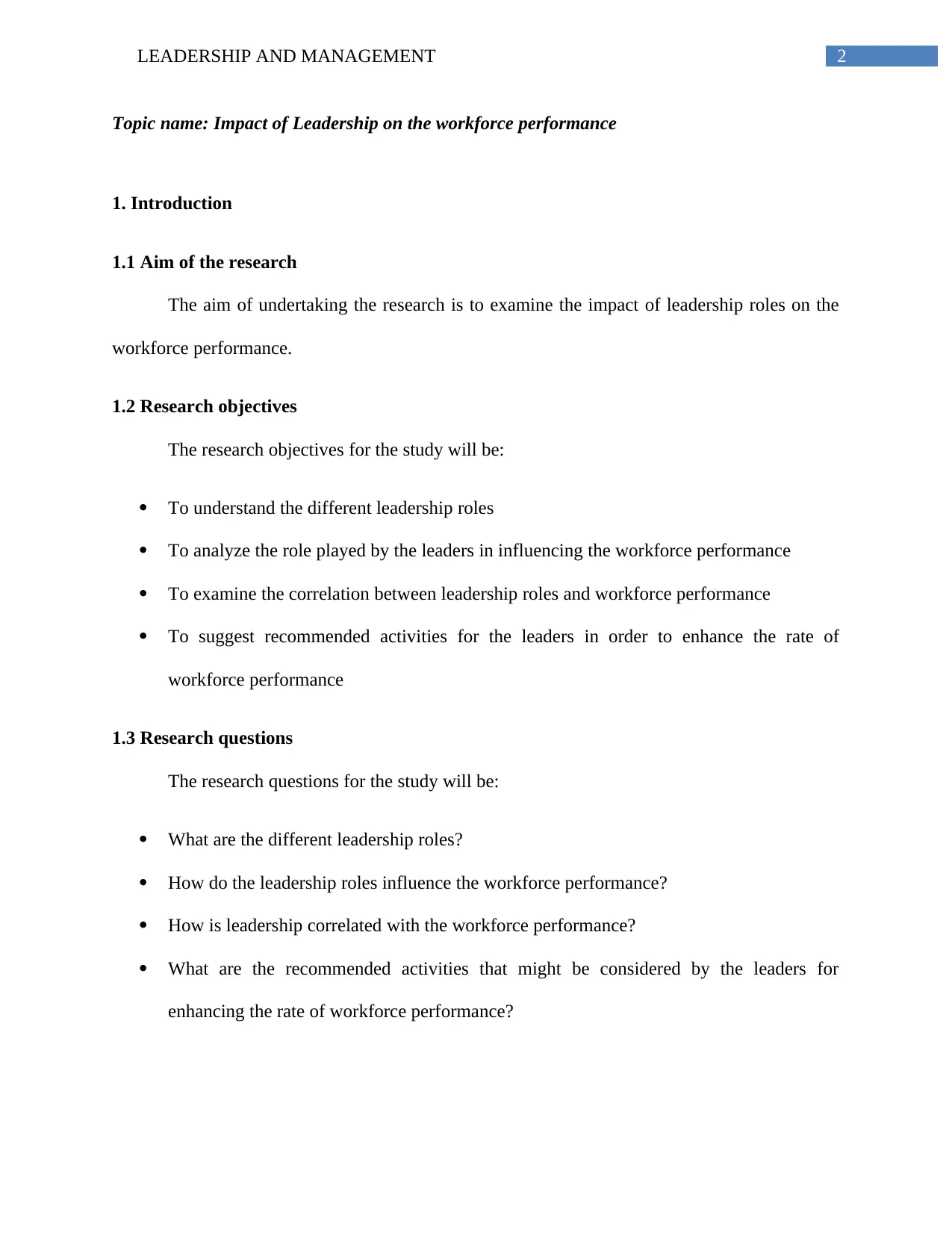
2LEADERSHIP AND MANAGEMENT
Topic name: Impact of Leadership on the workforce performance
1. Introduction
1.1 Aim of the research
The aim of undertaking the research is to examine the impact of leadership roles on the
workforce performance.
1.2 Research objectives
The research objectives for the study will be:
To understand the different leadership roles
To analyze the role played by the leaders in influencing the workforce performance
To examine the correlation between leadership roles and workforce performance
To suggest recommended activities for the leaders in order to enhance the rate of
workforce performance
1.3 Research questions
The research questions for the study will be:
What are the different leadership roles?
How do the leadership roles influence the workforce performance?
How is leadership correlated with the workforce performance?
What are the recommended activities that might be considered by the leaders for
enhancing the rate of workforce performance?
Topic name: Impact of Leadership on the workforce performance
1. Introduction
1.1 Aim of the research
The aim of undertaking the research is to examine the impact of leadership roles on the
workforce performance.
1.2 Research objectives
The research objectives for the study will be:
To understand the different leadership roles
To analyze the role played by the leaders in influencing the workforce performance
To examine the correlation between leadership roles and workforce performance
To suggest recommended activities for the leaders in order to enhance the rate of
workforce performance
1.3 Research questions
The research questions for the study will be:
What are the different leadership roles?
How do the leadership roles influence the workforce performance?
How is leadership correlated with the workforce performance?
What are the recommended activities that might be considered by the leaders for
enhancing the rate of workforce performance?
⊘ This is a preview!⊘
Do you want full access?
Subscribe today to unlock all pages.

Trusted by 1+ million students worldwide
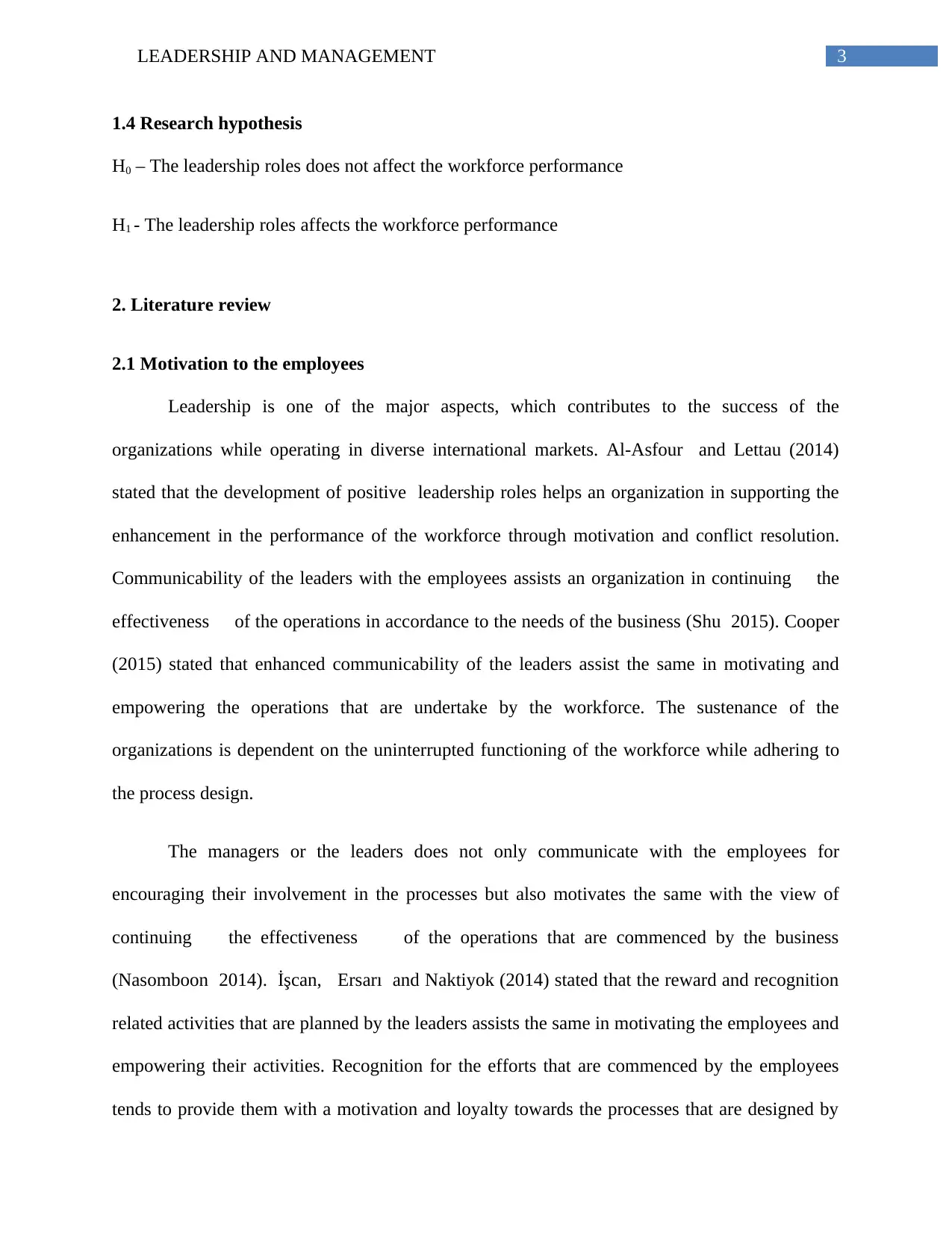
3LEADERSHIP AND MANAGEMENT
1.4 Research hypothesis
H0 – The leadership roles does not affect the workforce performance
H1 - The leadership roles affects the workforce performance
2. Literature review
2.1 Motivation to the employees
Leadership is one of the major aspects, which contributes to the success of the
organizations while operating in diverse international markets. Al-Asfour and Lettau (2014)
stated that the development of positive leadership roles helps an organization in supporting the
enhancement in the performance of the workforce through motivation and conflict resolution.
Communicability of the leaders with the employees assists an organization in continuing the
effectiveness of the operations in accordance to the needs of the business (Shu 2015). Cooper
(2015) stated that enhanced communicability of the leaders assist the same in motivating and
empowering the operations that are undertake by the workforce. The sustenance of the
organizations is dependent on the uninterrupted functioning of the workforce while adhering to
the process design.
The managers or the leaders does not only communicate with the employees for
encouraging their involvement in the processes but also motivates the same with the view of
continuing the effectiveness of the operations that are commenced by the business
(Nasomboon 2014). İşcan, Ersarı and Naktiyok (2014) stated that the reward and recognition
related activities that are planned by the leaders assists the same in motivating the employees and
empowering their activities. Recognition for the efforts that are commenced by the employees
tends to provide them with a motivation and loyalty towards the processes that are designed by
1.4 Research hypothesis
H0 – The leadership roles does not affect the workforce performance
H1 - The leadership roles affects the workforce performance
2. Literature review
2.1 Motivation to the employees
Leadership is one of the major aspects, which contributes to the success of the
organizations while operating in diverse international markets. Al-Asfour and Lettau (2014)
stated that the development of positive leadership roles helps an organization in supporting the
enhancement in the performance of the workforce through motivation and conflict resolution.
Communicability of the leaders with the employees assists an organization in continuing the
effectiveness of the operations in accordance to the needs of the business (Shu 2015). Cooper
(2015) stated that enhanced communicability of the leaders assist the same in motivating and
empowering the operations that are undertake by the workforce. The sustenance of the
organizations is dependent on the uninterrupted functioning of the workforce while adhering to
the process design.
The managers or the leaders does not only communicate with the employees for
encouraging their involvement in the processes but also motivates the same with the view of
continuing the effectiveness of the operations that are commenced by the business
(Nasomboon 2014). İşcan, Ersarı and Naktiyok (2014) stated that the reward and recognition
related activities that are planned by the leaders assists the same in motivating the employees and
empowering their activities. Recognition for the efforts that are commenced by the employees
tends to provide them with a motivation and loyalty towards the processes that are designed by
Paraphrase This Document
Need a fresh take? Get an instant paraphrase of this document with our AI Paraphraser
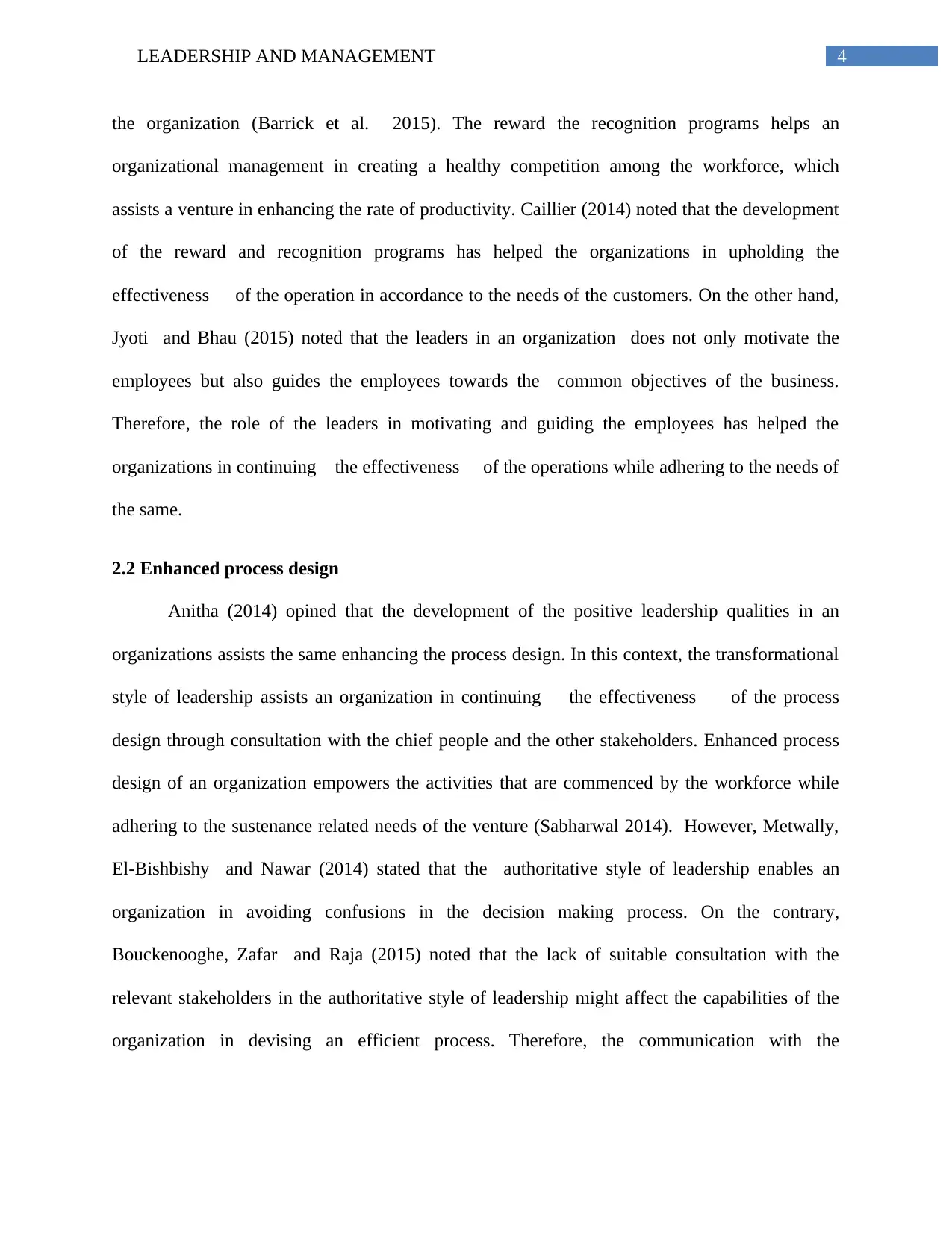
4LEADERSHIP AND MANAGEMENT
the organization (Barrick et al. 2015). The reward the recognition programs helps an
organizational management in creating a healthy competition among the workforce, which
assists a venture in enhancing the rate of productivity. Caillier (2014) noted that the development
of the reward and recognition programs has helped the organizations in upholding the
effectiveness of the operation in accordance to the needs of the customers. On the other hand,
Jyoti and Bhau (2015) noted that the leaders in an organization does not only motivate the
employees but also guides the employees towards the common objectives of the business.
Therefore, the role of the leaders in motivating and guiding the employees has helped the
organizations in continuing the effectiveness of the operations while adhering to the needs of
the same.
2.2 Enhanced process design
Anitha (2014) opined that the development of the positive leadership qualities in an
organizations assists the same enhancing the process design. In this context, the transformational
style of leadership assists an organization in continuing the effectiveness of the process
design through consultation with the chief people and the other stakeholders. Enhanced process
design of an organization empowers the activities that are commenced by the workforce while
adhering to the sustenance related needs of the venture (Sabharwal 2014). However, Metwally,
El-Bishbishy and Nawar (2014) stated that the authoritative style of leadership enables an
organization in avoiding confusions in the decision making process. On the contrary,
Bouckenooghe, Zafar and Raja (2015) noted that the lack of suitable consultation with the
relevant stakeholders in the authoritative style of leadership might affect the capabilities of the
organization in devising an efficient process. Therefore, the communication with the
the organization (Barrick et al. 2015). The reward the recognition programs helps an
organizational management in creating a healthy competition among the workforce, which
assists a venture in enhancing the rate of productivity. Caillier (2014) noted that the development
of the reward and recognition programs has helped the organizations in upholding the
effectiveness of the operation in accordance to the needs of the customers. On the other hand,
Jyoti and Bhau (2015) noted that the leaders in an organization does not only motivate the
employees but also guides the employees towards the common objectives of the business.
Therefore, the role of the leaders in motivating and guiding the employees has helped the
organizations in continuing the effectiveness of the operations while adhering to the needs of
the same.
2.2 Enhanced process design
Anitha (2014) opined that the development of the positive leadership qualities in an
organizations assists the same enhancing the process design. In this context, the transformational
style of leadership assists an organization in continuing the effectiveness of the process
design through consultation with the chief people and the other stakeholders. Enhanced process
design of an organization empowers the activities that are commenced by the workforce while
adhering to the sustenance related needs of the venture (Sabharwal 2014). However, Metwally,
El-Bishbishy and Nawar (2014) stated that the authoritative style of leadership enables an
organization in avoiding confusions in the decision making process. On the contrary,
Bouckenooghe, Zafar and Raja (2015) noted that the lack of suitable consultation with the
relevant stakeholders in the authoritative style of leadership might affect the capabilities of the
organization in devising an efficient process. Therefore, the communication with the
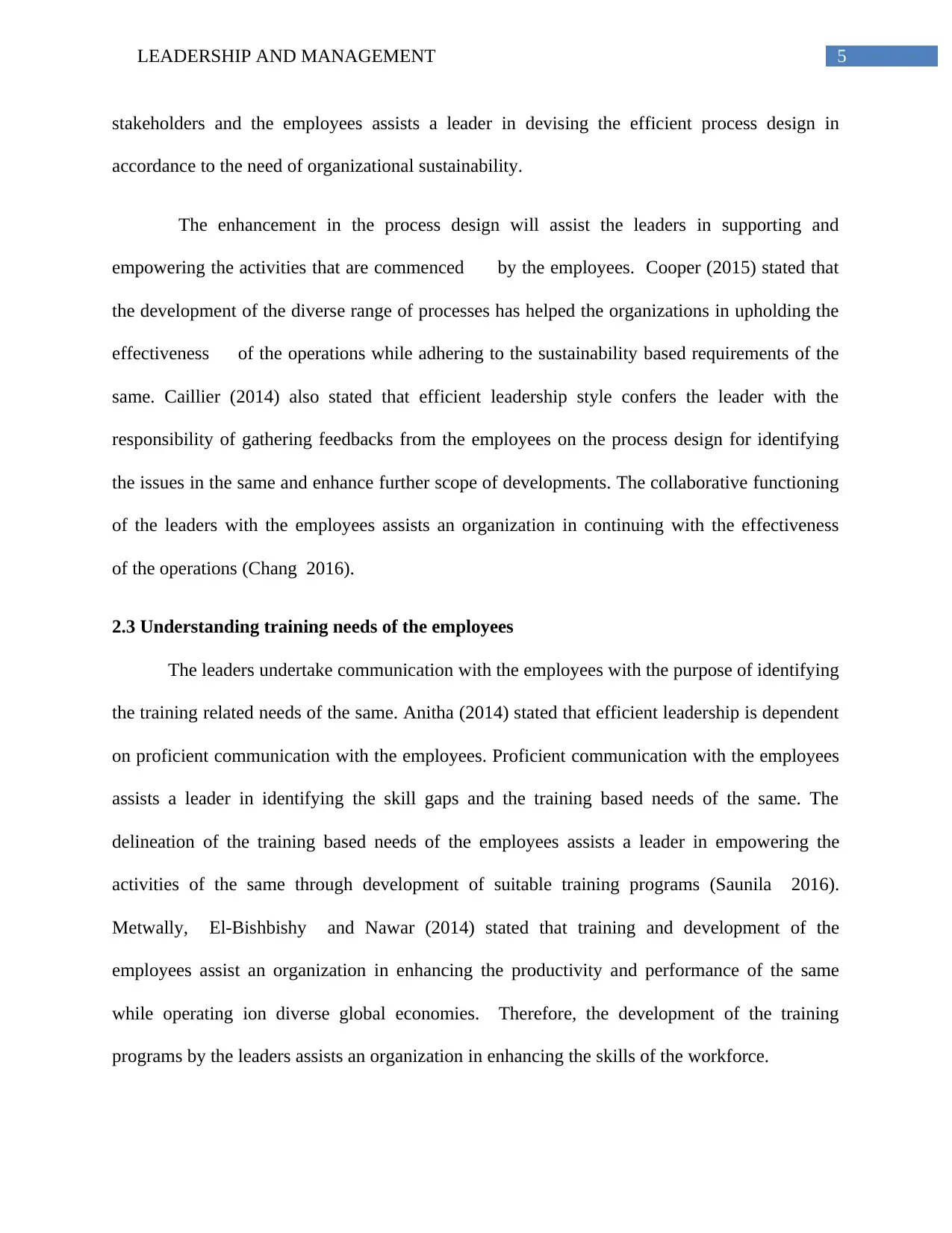
5LEADERSHIP AND MANAGEMENT
stakeholders and the employees assists a leader in devising the efficient process design in
accordance to the need of organizational sustainability.
The enhancement in the process design will assist the leaders in supporting and
empowering the activities that are commenced by the employees. Cooper (2015) stated that
the development of the diverse range of processes has helped the organizations in upholding the
effectiveness of the operations while adhering to the sustainability based requirements of the
same. Caillier (2014) also stated that efficient leadership style confers the leader with the
responsibility of gathering feedbacks from the employees on the process design for identifying
the issues in the same and enhance further scope of developments. The collaborative functioning
of the leaders with the employees assists an organization in continuing with the effectiveness
of the operations (Chang 2016).
2.3 Understanding training needs of the employees
The leaders undertake communication with the employees with the purpose of identifying
the training related needs of the same. Anitha (2014) stated that efficient leadership is dependent
on proficient communication with the employees. Proficient communication with the employees
assists a leader in identifying the skill gaps and the training based needs of the same. The
delineation of the training based needs of the employees assists a leader in empowering the
activities of the same through development of suitable training programs (Saunila 2016).
Metwally, El-Bishbishy and Nawar (2014) stated that training and development of the
employees assist an organization in enhancing the productivity and performance of the same
while operating ion diverse global economies. Therefore, the development of the training
programs by the leaders assists an organization in enhancing the skills of the workforce.
stakeholders and the employees assists a leader in devising the efficient process design in
accordance to the need of organizational sustainability.
The enhancement in the process design will assist the leaders in supporting and
empowering the activities that are commenced by the employees. Cooper (2015) stated that
the development of the diverse range of processes has helped the organizations in upholding the
effectiveness of the operations while adhering to the sustainability based requirements of the
same. Caillier (2014) also stated that efficient leadership style confers the leader with the
responsibility of gathering feedbacks from the employees on the process design for identifying
the issues in the same and enhance further scope of developments. The collaborative functioning
of the leaders with the employees assists an organization in continuing with the effectiveness
of the operations (Chang 2016).
2.3 Understanding training needs of the employees
The leaders undertake communication with the employees with the purpose of identifying
the training related needs of the same. Anitha (2014) stated that efficient leadership is dependent
on proficient communication with the employees. Proficient communication with the employees
assists a leader in identifying the skill gaps and the training based needs of the same. The
delineation of the training based needs of the employees assists a leader in empowering the
activities of the same through development of suitable training programs (Saunila 2016).
Metwally, El-Bishbishy and Nawar (2014) stated that training and development of the
employees assist an organization in enhancing the productivity and performance of the same
while operating ion diverse global economies. Therefore, the development of the training
programs by the leaders assists an organization in enhancing the skills of the workforce.
⊘ This is a preview!⊘
Do you want full access?
Subscribe today to unlock all pages.

Trusted by 1+ million students worldwide
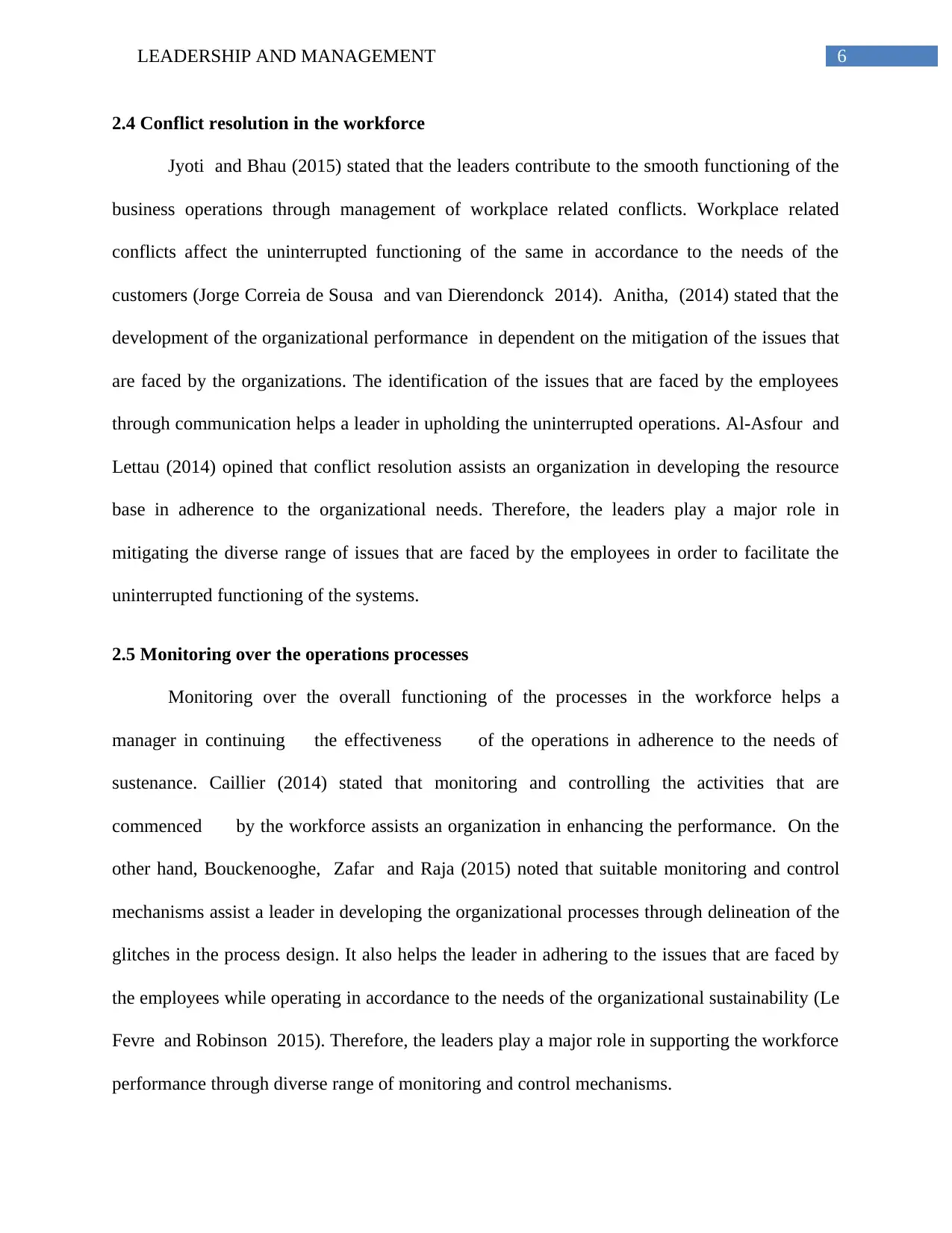
6LEADERSHIP AND MANAGEMENT
2.4 Conflict resolution in the workforce
Jyoti and Bhau (2015) stated that the leaders contribute to the smooth functioning of the
business operations through management of workplace related conflicts. Workplace related
conflicts affect the uninterrupted functioning of the same in accordance to the needs of the
customers (Jorge Correia de Sousa and van Dierendonck 2014). Anitha, (2014) stated that the
development of the organizational performance in dependent on the mitigation of the issues that
are faced by the organizations. The identification of the issues that are faced by the employees
through communication helps a leader in upholding the uninterrupted operations. Al-Asfour and
Lettau (2014) opined that conflict resolution assists an organization in developing the resource
base in adherence to the organizational needs. Therefore, the leaders play a major role in
mitigating the diverse range of issues that are faced by the employees in order to facilitate the
uninterrupted functioning of the systems.
2.5 Monitoring over the operations processes
Monitoring over the overall functioning of the processes in the workforce helps a
manager in continuing the effectiveness of the operations in adherence to the needs of
sustenance. Caillier (2014) stated that monitoring and controlling the activities that are
commenced by the workforce assists an organization in enhancing the performance. On the
other hand, Bouckenooghe, Zafar and Raja (2015) noted that suitable monitoring and control
mechanisms assist a leader in developing the organizational processes through delineation of the
glitches in the process design. It also helps the leader in adhering to the issues that are faced by
the employees while operating in accordance to the needs of the organizational sustainability (Le
Fevre and Robinson 2015). Therefore, the leaders play a major role in supporting the workforce
performance through diverse range of monitoring and control mechanisms.
2.4 Conflict resolution in the workforce
Jyoti and Bhau (2015) stated that the leaders contribute to the smooth functioning of the
business operations through management of workplace related conflicts. Workplace related
conflicts affect the uninterrupted functioning of the same in accordance to the needs of the
customers (Jorge Correia de Sousa and van Dierendonck 2014). Anitha, (2014) stated that the
development of the organizational performance in dependent on the mitigation of the issues that
are faced by the organizations. The identification of the issues that are faced by the employees
through communication helps a leader in upholding the uninterrupted operations. Al-Asfour and
Lettau (2014) opined that conflict resolution assists an organization in developing the resource
base in adherence to the organizational needs. Therefore, the leaders play a major role in
mitigating the diverse range of issues that are faced by the employees in order to facilitate the
uninterrupted functioning of the systems.
2.5 Monitoring over the operations processes
Monitoring over the overall functioning of the processes in the workforce helps a
manager in continuing the effectiveness of the operations in adherence to the needs of
sustenance. Caillier (2014) stated that monitoring and controlling the activities that are
commenced by the workforce assists an organization in enhancing the performance. On the
other hand, Bouckenooghe, Zafar and Raja (2015) noted that suitable monitoring and control
mechanisms assist a leader in developing the organizational processes through delineation of the
glitches in the process design. It also helps the leader in adhering to the issues that are faced by
the employees while operating in accordance to the needs of the organizational sustainability (Le
Fevre and Robinson 2015). Therefore, the leaders play a major role in supporting the workforce
performance through diverse range of monitoring and control mechanisms.
Paraphrase This Document
Need a fresh take? Get an instant paraphrase of this document with our AI Paraphraser
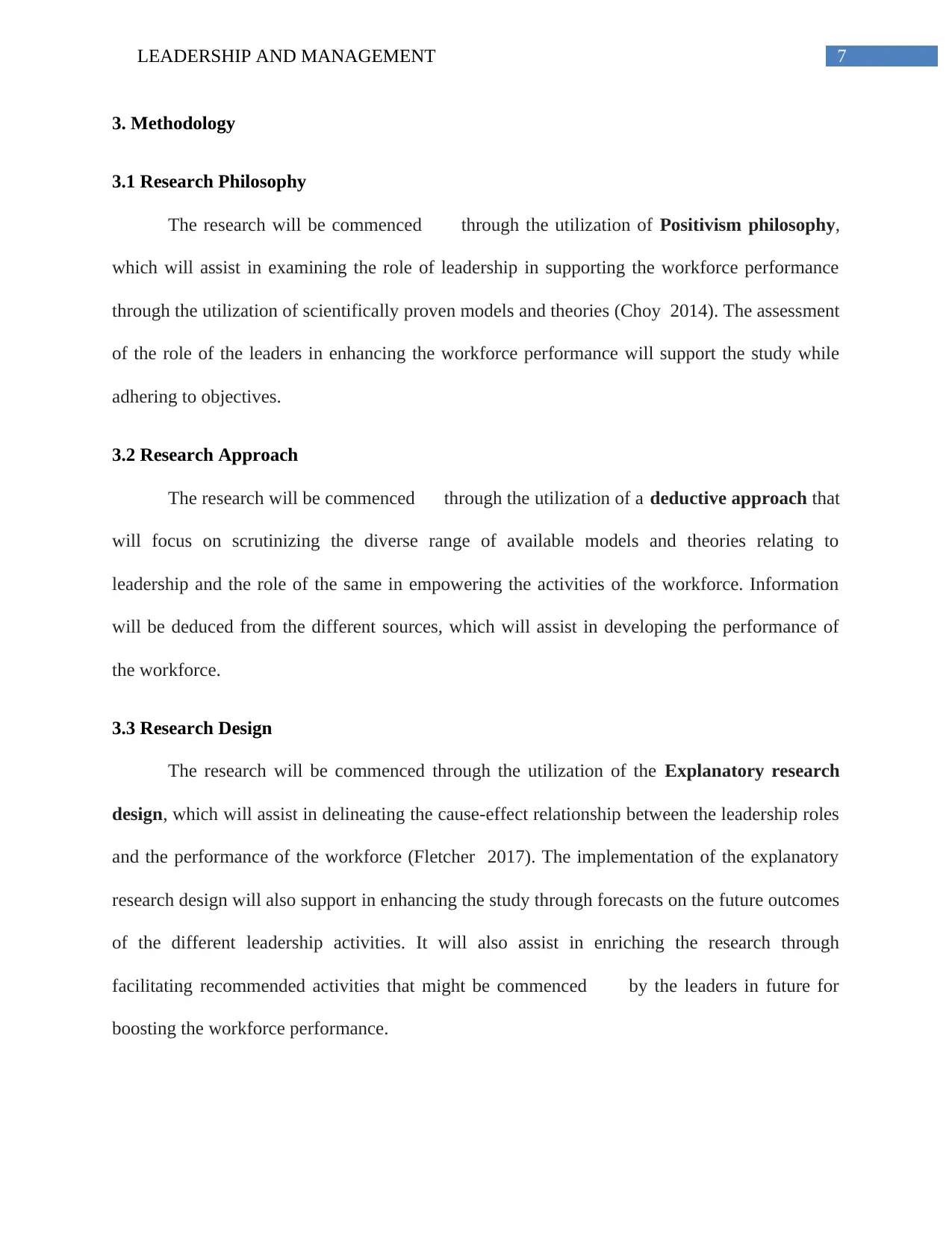
7LEADERSHIP AND MANAGEMENT
3. Methodology
3.1 Research Philosophy
The research will be commenced through the utilization of Positivism philosophy,
which will assist in examining the role of leadership in supporting the workforce performance
through the utilization of scientifically proven models and theories (Choy 2014). The assessment
of the role of the leaders in enhancing the workforce performance will support the study while
adhering to objectives.
3.2 Research Approach
The research will be commenced through the utilization of a deductive approach that
will focus on scrutinizing the diverse range of available models and theories relating to
leadership and the role of the same in empowering the activities of the workforce. Information
will be deduced from the different sources, which will assist in developing the performance of
the workforce.
3.3 Research Design
The research will be commenced through the utilization of the Explanatory research
design, which will assist in delineating the cause-effect relationship between the leadership roles
and the performance of the workforce (Fletcher 2017). The implementation of the explanatory
research design will also support in enhancing the study through forecasts on the future outcomes
of the different leadership activities. It will also assist in enriching the research through
facilitating recommended activities that might be commenced by the leaders in future for
boosting the workforce performance.
3. Methodology
3.1 Research Philosophy
The research will be commenced through the utilization of Positivism philosophy,
which will assist in examining the role of leadership in supporting the workforce performance
through the utilization of scientifically proven models and theories (Choy 2014). The assessment
of the role of the leaders in enhancing the workforce performance will support the study while
adhering to objectives.
3.2 Research Approach
The research will be commenced through the utilization of a deductive approach that
will focus on scrutinizing the diverse range of available models and theories relating to
leadership and the role of the same in empowering the activities of the workforce. Information
will be deduced from the different sources, which will assist in developing the performance of
the workforce.
3.3 Research Design
The research will be commenced through the utilization of the Explanatory research
design, which will assist in delineating the cause-effect relationship between the leadership roles
and the performance of the workforce (Fletcher 2017). The implementation of the explanatory
research design will also support in enhancing the study through forecasts on the future outcomes
of the different leadership activities. It will also assist in enriching the research through
facilitating recommended activities that might be commenced by the leaders in future for
boosting the workforce performance.
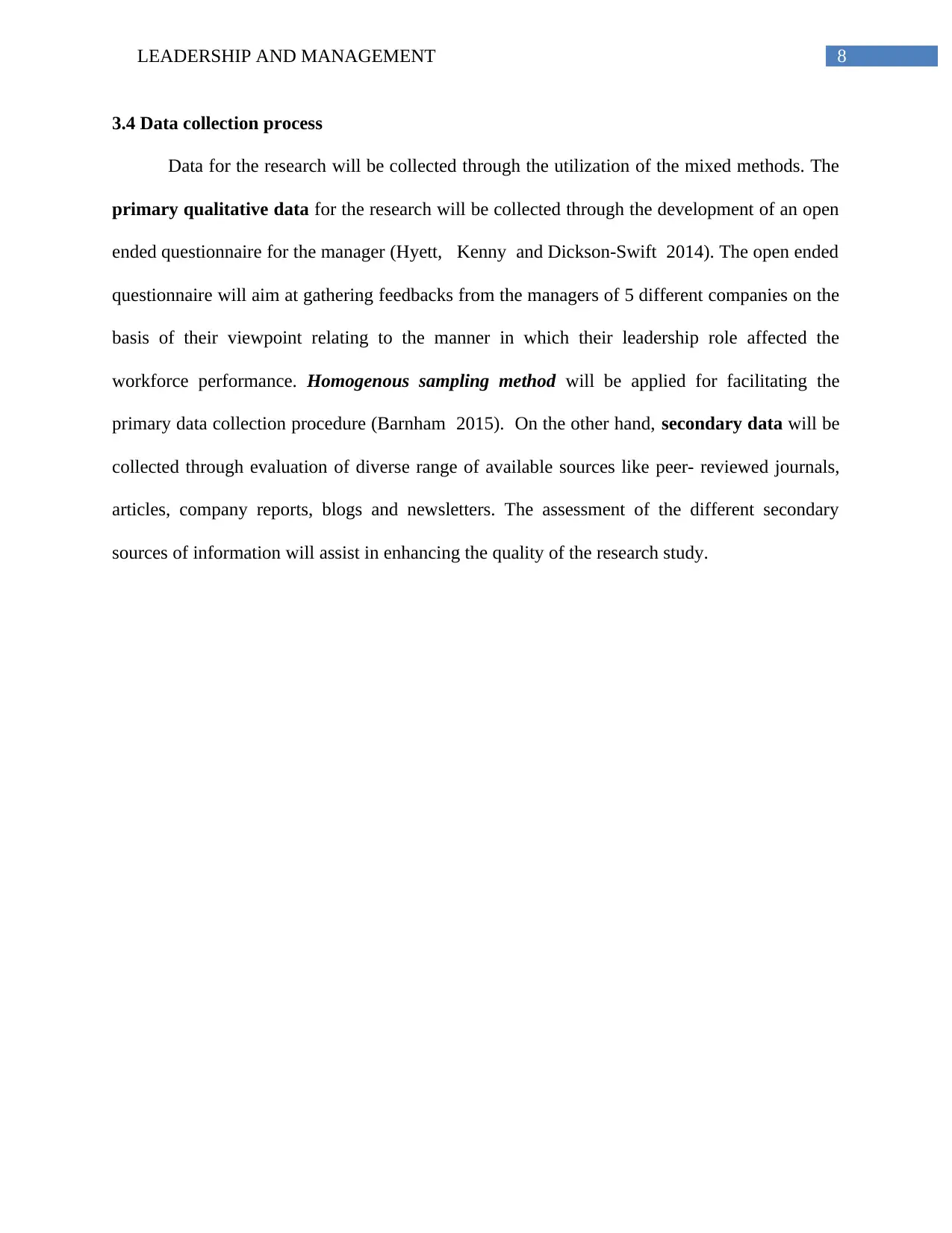
8LEADERSHIP AND MANAGEMENT
3.4 Data collection process
Data for the research will be collected through the utilization of the mixed methods. The
primary qualitative data for the research will be collected through the development of an open
ended questionnaire for the manager (Hyett, Kenny and Dickson-Swift 2014). The open ended
questionnaire will aim at gathering feedbacks from the managers of 5 different companies on the
basis of their viewpoint relating to the manner in which their leadership role affected the
workforce performance. Homogenous sampling method will be applied for facilitating the
primary data collection procedure (Barnham 2015). On the other hand, secondary data will be
collected through evaluation of diverse range of available sources like peer- reviewed journals,
articles, company reports, blogs and newsletters. The assessment of the different secondary
sources of information will assist in enhancing the quality of the research study.
3.4 Data collection process
Data for the research will be collected through the utilization of the mixed methods. The
primary qualitative data for the research will be collected through the development of an open
ended questionnaire for the manager (Hyett, Kenny and Dickson-Swift 2014). The open ended
questionnaire will aim at gathering feedbacks from the managers of 5 different companies on the
basis of their viewpoint relating to the manner in which their leadership role affected the
workforce performance. Homogenous sampling method will be applied for facilitating the
primary data collection procedure (Barnham 2015). On the other hand, secondary data will be
collected through evaluation of diverse range of available sources like peer- reviewed journals,
articles, company reports, blogs and newsletters. The assessment of the different secondary
sources of information will assist in enhancing the quality of the research study.
⊘ This is a preview!⊘
Do you want full access?
Subscribe today to unlock all pages.

Trusted by 1+ million students worldwide
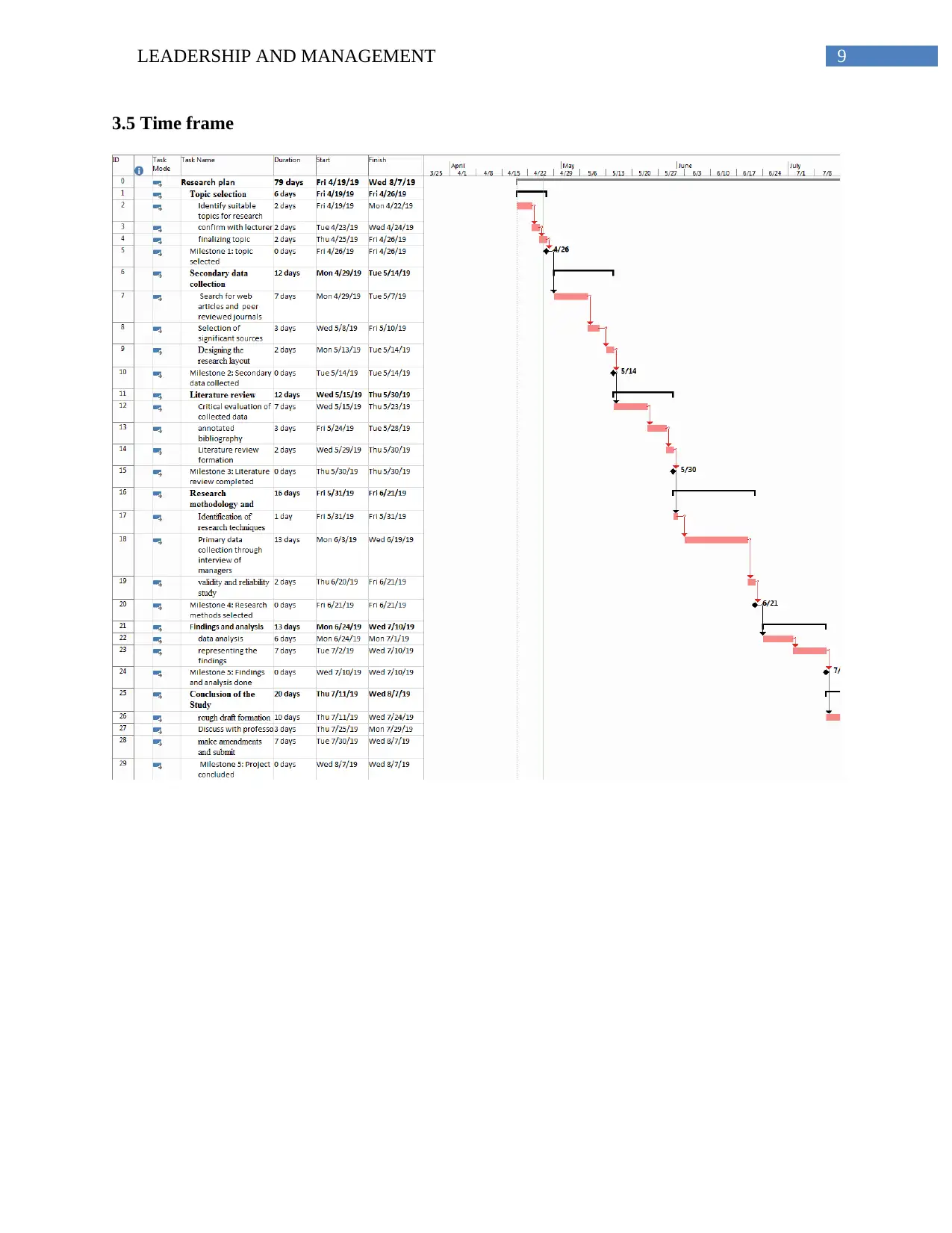
9LEADERSHIP AND MANAGEMENT
3.5 Time frame
3.5 Time frame
Paraphrase This Document
Need a fresh take? Get an instant paraphrase of this document with our AI Paraphraser
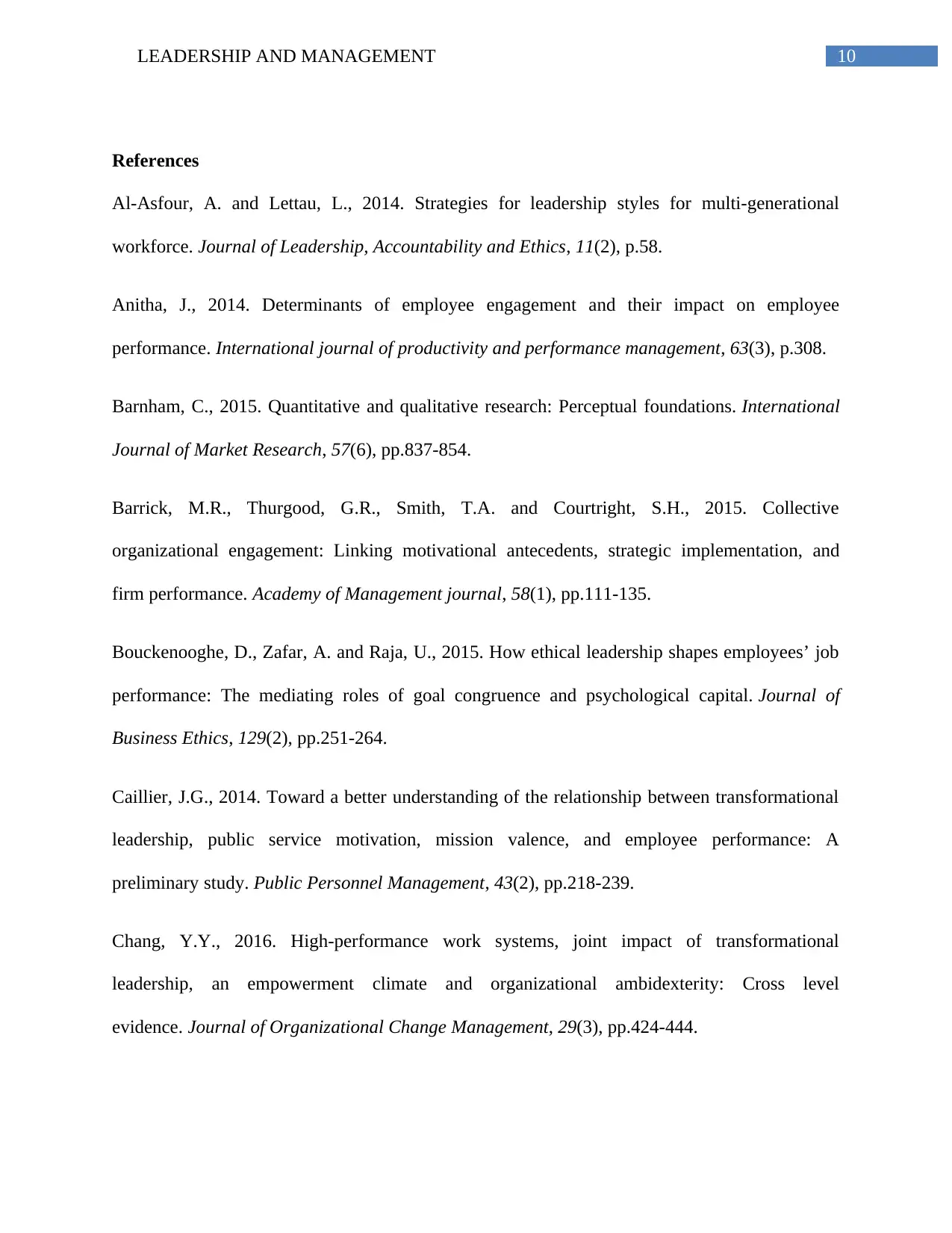
10LEADERSHIP AND MANAGEMENT
References
Al-Asfour, A. and Lettau, L., 2014. Strategies for leadership styles for multi-generational
workforce. Journal of Leadership, Accountability and Ethics, 11(2), p.58.
Anitha, J., 2014. Determinants of employee engagement and their impact on employee
performance. International journal of productivity and performance management, 63(3), p.308.
Barnham, C., 2015. Quantitative and qualitative research: Perceptual foundations. International
Journal of Market Research, 57(6), pp.837-854.
Barrick, M.R., Thurgood, G.R., Smith, T.A. and Courtright, S.H., 2015. Collective
organizational engagement: Linking motivational antecedents, strategic implementation, and
firm performance. Academy of Management journal, 58(1), pp.111-135.
Bouckenooghe, D., Zafar, A. and Raja, U., 2015. How ethical leadership shapes employees’ job
performance: The mediating roles of goal congruence and psychological capital. Journal of
Business Ethics, 129(2), pp.251-264.
Caillier, J.G., 2014. Toward a better understanding of the relationship between transformational
leadership, public service motivation, mission valence, and employee performance: A
preliminary study. Public Personnel Management, 43(2), pp.218-239.
Chang, Y.Y., 2016. High-performance work systems, joint impact of transformational
leadership, an empowerment climate and organizational ambidexterity: Cross level
evidence. Journal of Organizational Change Management, 29(3), pp.424-444.
References
Al-Asfour, A. and Lettau, L., 2014. Strategies for leadership styles for multi-generational
workforce. Journal of Leadership, Accountability and Ethics, 11(2), p.58.
Anitha, J., 2014. Determinants of employee engagement and their impact on employee
performance. International journal of productivity and performance management, 63(3), p.308.
Barnham, C., 2015. Quantitative and qualitative research: Perceptual foundations. International
Journal of Market Research, 57(6), pp.837-854.
Barrick, M.R., Thurgood, G.R., Smith, T.A. and Courtright, S.H., 2015. Collective
organizational engagement: Linking motivational antecedents, strategic implementation, and
firm performance. Academy of Management journal, 58(1), pp.111-135.
Bouckenooghe, D., Zafar, A. and Raja, U., 2015. How ethical leadership shapes employees’ job
performance: The mediating roles of goal congruence and psychological capital. Journal of
Business Ethics, 129(2), pp.251-264.
Caillier, J.G., 2014. Toward a better understanding of the relationship between transformational
leadership, public service motivation, mission valence, and employee performance: A
preliminary study. Public Personnel Management, 43(2), pp.218-239.
Chang, Y.Y., 2016. High-performance work systems, joint impact of transformational
leadership, an empowerment climate and organizational ambidexterity: Cross level
evidence. Journal of Organizational Change Management, 29(3), pp.424-444.
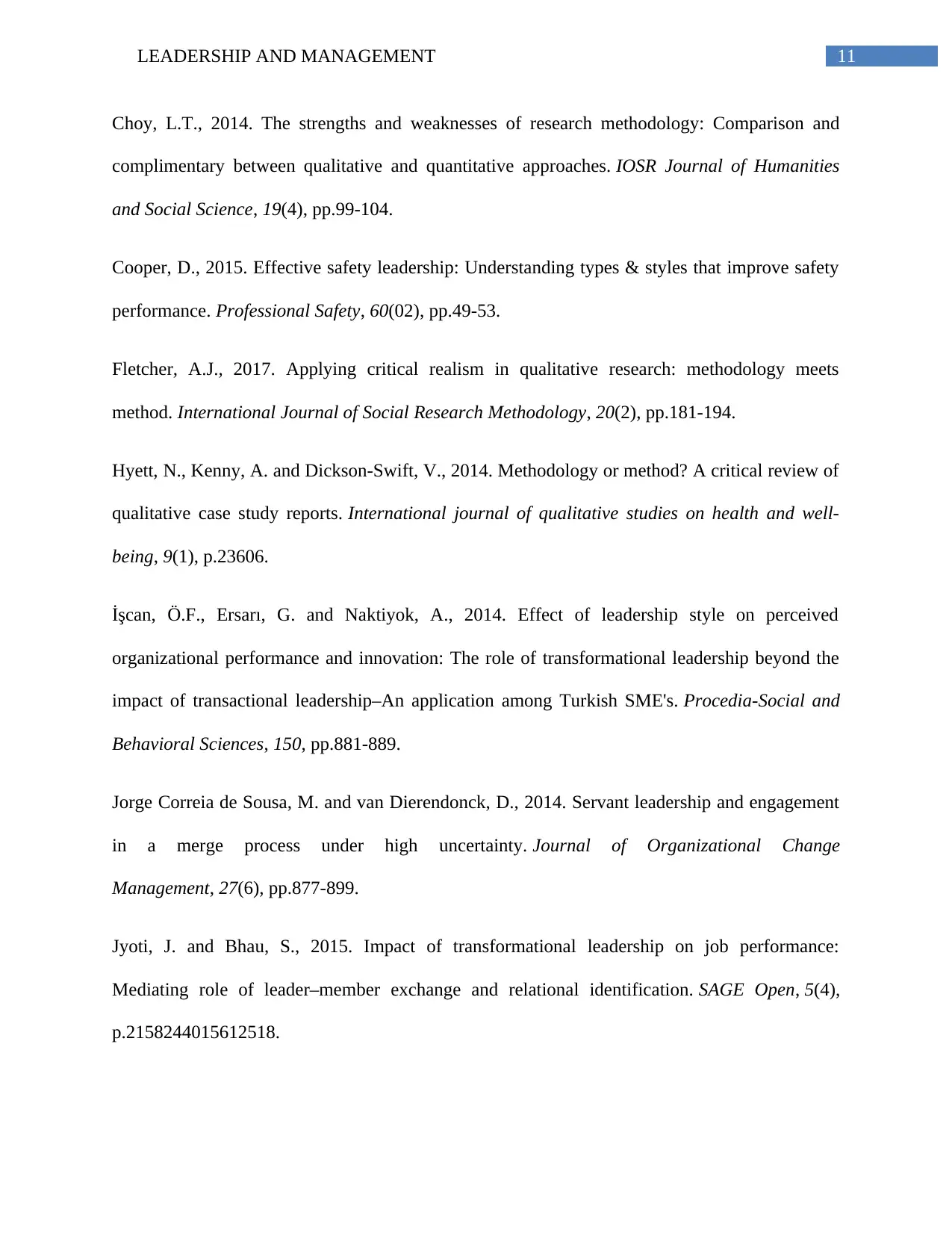
11LEADERSHIP AND MANAGEMENT
Choy, L.T., 2014. The strengths and weaknesses of research methodology: Comparison and
complimentary between qualitative and quantitative approaches. IOSR Journal of Humanities
and Social Science, 19(4), pp.99-104.
Cooper, D., 2015. Effective safety leadership: Understanding types & styles that improve safety
performance. Professional Safety, 60(02), pp.49-53.
Fletcher, A.J., 2017. Applying critical realism in qualitative research: methodology meets
method. International Journal of Social Research Methodology, 20(2), pp.181-194.
Hyett, N., Kenny, A. and Dickson-Swift, V., 2014. Methodology or method? A critical review of
qualitative case study reports. International journal of qualitative studies on health and well-
being, 9(1), p.23606.
İşcan, Ö.F., Ersarı, G. and Naktiyok, A., 2014. Effect of leadership style on perceived
organizational performance and innovation: The role of transformational leadership beyond the
impact of transactional leadership–An application among Turkish SME's. Procedia-Social and
Behavioral Sciences, 150, pp.881-889.
Jorge Correia de Sousa, M. and van Dierendonck, D., 2014. Servant leadership and engagement
in a merge process under high uncertainty. Journal of Organizational Change
Management, 27(6), pp.877-899.
Jyoti, J. and Bhau, S., 2015. Impact of transformational leadership on job performance:
Mediating role of leader–member exchange and relational identification. SAGE Open, 5(4),
p.2158244015612518.
Choy, L.T., 2014. The strengths and weaknesses of research methodology: Comparison and
complimentary between qualitative and quantitative approaches. IOSR Journal of Humanities
and Social Science, 19(4), pp.99-104.
Cooper, D., 2015. Effective safety leadership: Understanding types & styles that improve safety
performance. Professional Safety, 60(02), pp.49-53.
Fletcher, A.J., 2017. Applying critical realism in qualitative research: methodology meets
method. International Journal of Social Research Methodology, 20(2), pp.181-194.
Hyett, N., Kenny, A. and Dickson-Swift, V., 2014. Methodology or method? A critical review of
qualitative case study reports. International journal of qualitative studies on health and well-
being, 9(1), p.23606.
İşcan, Ö.F., Ersarı, G. and Naktiyok, A., 2014. Effect of leadership style on perceived
organizational performance and innovation: The role of transformational leadership beyond the
impact of transactional leadership–An application among Turkish SME's. Procedia-Social and
Behavioral Sciences, 150, pp.881-889.
Jorge Correia de Sousa, M. and van Dierendonck, D., 2014. Servant leadership and engagement
in a merge process under high uncertainty. Journal of Organizational Change
Management, 27(6), pp.877-899.
Jyoti, J. and Bhau, S., 2015. Impact of transformational leadership on job performance:
Mediating role of leader–member exchange and relational identification. SAGE Open, 5(4),
p.2158244015612518.
⊘ This is a preview!⊘
Do you want full access?
Subscribe today to unlock all pages.

Trusted by 1+ million students worldwide
1 out of 14
Related Documents
Your All-in-One AI-Powered Toolkit for Academic Success.
+13062052269
info@desklib.com
Available 24*7 on WhatsApp / Email
![[object Object]](/_next/static/media/star-bottom.7253800d.svg)
Unlock your academic potential
Copyright © 2020–2025 A2Z Services. All Rights Reserved. Developed and managed by ZUCOL.





